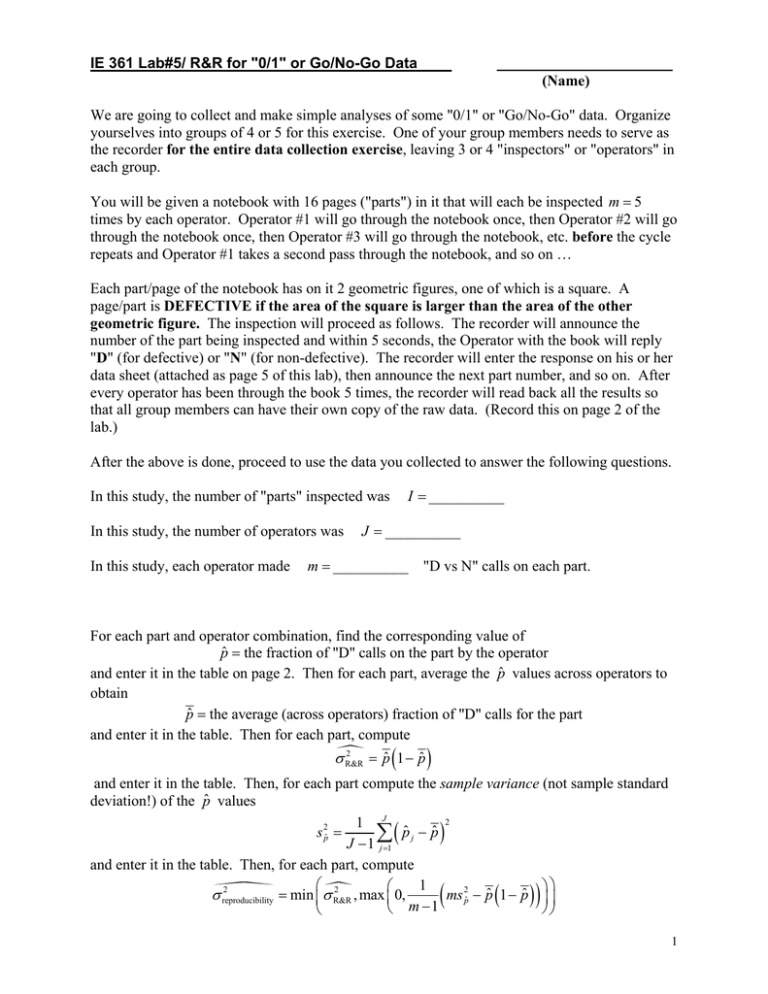Document 11596893
advertisement

IE 361 Lab#5/ R&R for "0/1" or Go/No-Go Data _____________________ (Name) We are going to collect and make simple analyses of some "0/1" or "Go/No-Go" data. Organize yourselves into groups of 4 or 5 for this exercise. One of your group members needs to serve as the recorder for the entire data collection exercise, leaving 3 or 4 "inspectors" or "operators" in each group. You will be given a notebook with 16 pages ("parts") in it that will each be inspected m = 5 times by each operator. Operator #1 will go through the notebook once, then Operator #2 will go through the notebook once, then Operator #3 will go through the notebook, etc. before the cycle repeats and Operator #1 takes a second pass through the notebook, and so on … Each part/page of the notebook has on it 2 geometric figures, one of which is a square. A page/part is DEFECTIVE if the area of the square is larger than the area of the other geometric figure. The inspection will proceed as follows. The recorder will announce the number of the part being inspected and within 5 seconds, the Operator with the book will reply "D" (for defective) or "N" (for non-defective). The recorder will enter the response on his or her data sheet (attached as page 5 of this lab), then announce the next part number, and so on. After every operator has been through the book 5 times, the recorder will read back all the results so that all group members can have their own copy of the raw data. (Record this on page 2 of the lab.) After the above is done, proceed to use the data you collected to answer the following questions. I = __________ In this study, the number of "parts" inspected was In this study, the number of operators was In this study, each operator made J = __________ m = __________ "D vs N" calls on each part. For each part and operator combination, find the corresponding value of pˆ = the fraction of "D" calls on the part by the operator and enter it in the table on page 2. Then for each part, average the p̂ values across operators to obtain pˆ = the average (across operators) fraction of "D" calls for the part and enter it in the table. Then for each part, compute 2 σn = pˆ 1 − pˆ R&R ( ) and enter it in the table. Then, for each part compute the sample variance (not sample standard deviation!) of the p̂ values 2 1 J s 2pˆ = pˆ j − pˆ ∑ J − 1 j =1 and enter it in the table. Then, for each part, compute ⎛n 1 ⎛ ⎞⎞ 2 2 σn ms 2pˆ − pˆ 1 − pˆ ⎟ ⎟ reproducibility = min ⎜ σ R&R , max ⎜ 0, ⎝ m −1 ⎠⎠ ⎝ ( ) ( ( )) 1 and n n 2 2 2 σn repeatability = σ R&R − σ reproducibility and enter them in the table. Finally, average each of n n 2 2 2 σn R&R , σ reproducibility , and σ repeatability across the I parts and record the averages on the bottom margin of the table. Operator p̂ Part #1 #2 #3 #4 p̂ 2 σn R&R s 2p̂ 2 σn reproducibility 2 σn repeatability 1 2 3 4 5 6 7 8 9 10 11 12 13 14 15 16 1) Based on your average values for estimated variances at the bottom of the above table, is there substantially more inconsistency in the D/N calls than can be accounted for by binomial variation (the basic repeatability variation here)? (Are there clear consistent differences between operators?) Explain. 2 2) Use the modification of the Stat 231 large sample confidence interval formula for estimation of p1 − p2 , namely p1 (1 − p1 ) p 2 (1 − p 2 ) + n1 n2 (where p is gotten from p̂ by adding a fictitious 2 "successes" in a fictitious 4 additional "trials" to the successes and trials that go into p̂ ), to compare Operator #1 to Operator #2 on their probabilities of calling Part #9 as "D." (Use a nominal 95% confidence level.) pˆ1 − pˆ 2 ± z 3) What does the interval in 2) tell you in the context of this particular set of inspection outcomes? 3 4) There might be interest in comparing average (across parts) probabilities of making a "D" call for Operators #1 and #2. A "rough and ready" way to do this (assuming that the I parts in the study are a "random sample" of parts of interest) is to treat the I values pˆ1 − pˆ 2 as a sample of I observations y and to use the one-sample inference formula for a mean employed in Module 2, namely s y ±t for ν = n − 1 n (here "n" = I ). Use this method and make 95% confidence limits for the average (across parts) difference in likelihoods that Operators #1 and #2 make a "D" call. 5) By the standard of part 4) above, is there a clear difference between how Operators #1 and #2 make D/N calls? Explain. 4 Process # ___________ Part # 1 2 3 4 5 6 7 8 9 10 11 12 13 14 15 16 Operator 1 Round Number 1 2 3 4 5 p̂1 Operator 2 Round Number 1 2 3 4 5 p̂2 Operator 3 Round Number 1 2 3 4 5 p̂3 Operator 4 Round Number 1 2 3 4 5 p̂4 p̂




